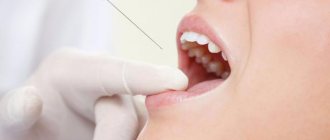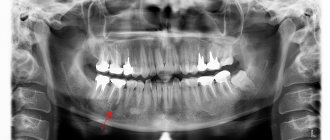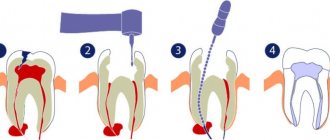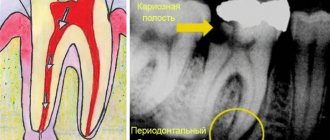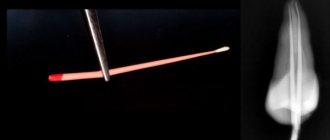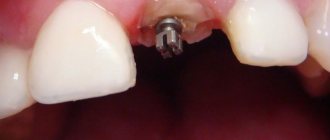Many dental diseases develop latently for quite a long time and, like many other diseases, in the first stages of development they are easily and simply controlled, for example cysts, which can be easily treated with conservative and non-surgical methods, the main thing is not to let the problem take its course.
The main problem of diagnosis and timely dental treatment is that patients, who remember what dentistry was like in the USSR, prefer to endure and ignore the initial symptoms “until the last” and turn to the dentist after the development of complications or already in advanced situations, when without surgical intervention not enough.
In addition, there are a number of diseases that appear and develop without pain or discomfort, asymptomatically, and therefore are discovered completely by chance on an x-ray or already at the stage when there are visible signs of inflammation and the preservation of the tooth becomes doubtful. Such dangerous and hidden pathological processes include a dental cyst, which does not manifest itself in any way, is detected by chance and so surprises patients with completely unexpected worries and expenses.
What is a dental cyst?
A cyst is any cavity formation that forms inside the jaw bone or in the gum and limits the penetration of infection from the source of inflammation into healthy tissue.
A dental cyst develops very slowly and its development begins with the penetration of infectious agents, microbes and inflammatory products into the tissue around the tooth root, which the body cannot cope with. The human defense system tries to autonomously fight inflammatory and necrotic processes but, unfortunately, is defeated. To prevent further spread of the infection, a capsule is formed filled with decay products of dead and infected bone cells; the body tries to prevent the infection from spreading to surrounding tissues.
!Important: The main inconvenience and problem is that such hidden cystic processes, regardless of location (no matter in the jaw, in the abdominal cavity or in the ovary), always develop asymptomatically and unnoticeably. And the most annoying thing is that these formations are found only during an exacerbation, when a surgeon is already needed.
Now in our clinic there is a special diagnostic case “CT scan for searching for hidden cysts.”
All dental cysts will have to be treated, even if nothing bothers you. In order not to waste time, it is better to delay, as they gradually increase and involve the surrounding tissues in the pathological process. The result of this progression of the disease is periostitis, known to ordinary people as “flux”. A pronounced clinical picture of inflammation develops with pain, swelling and hyperemia, the main treatment for which, unfortunately, will only be tooth extraction followed by extraction of the cyst.
!Important: Currently, there is a lot of information about the treatment of cysts with laser. However, the confusion of information makes it impossible to understand the problem of using medical lasers to treat cysts.
Currently there is:
- Laser sterilization of canals using a SIRONA laser or other devices.
Plus : Modern, fashionable, there is an illusion of expensive quality. Disadvantage : the price is inadequate, there is no medical evidence of the advantages of this type of treatment over other methods of canal sterilization. Very questionable marketing.
- Laser surgery of the cyst shell itself, laser disinfection of the cavity in the bone.
Plus: Super speed of the operation, burning out the cyst occurs literally in seconds. Minus : unforgettable smell, heals worse, the result of healing of the wound surface after a laser burn is worse and longer than after surgical removal of the cyst. We haven't used it for two years now.
!Important: Please understand that laser canal treatment is a marketing term that duplicates the classic treatment of root canals with a contact antiseptic. Despite the modernity of this method of dealing with the problem, such as “laser cyst treatment”, its effectiveness remains in doubt, and therefore you should not rely too much on it.
Cost of dental cystectomy service
| Name | Cost, rub) |
| Appointment (examination, consultation) with a dental surgeon | For free |
| Cystectomy (includes resection of the root apex, anesthesia, sutures, collagen osteoplastic material, retrograde filling) | 10 000 |
When paying in cash there is a 5% discount
In our clinic you can get a free consultation with a dental surgeon!
Why does a dental cyst develop?
There are several main reasons for the development of dental cysts. The main factors that provoke the formation of cysts:
- Mechanical damage to the gums (injuries can be very minor, for example, wounds from nut shell fragments). Infections of the oral cavity (small scratches on the gum are enough for pathological microorganisms to penetrate into its tissues and form a cavity inside that is invisible to the patient and even dentists for a long time); A periodontal cyst appears .
- Complications after unprofessional dental procedures (incorrect installation of fillings, insufficient cleaning of the canals, inadequate treatment of caries and other procedures); Pulpitis develops, then periodontitis, and a radicular cyst .
- Problematic and difficult to erupt wisdom teeth. follicular appears .
- Soft tissue cysts and cysts in the lymph nodes. Infectious pathologies of the upper respiratory tract (these structures are closely related to the oral cavity, therefore the mechanism of cyst development is the same as in the previous version, and the spread of bacteria through the blood and lymph cannot be ruled out).
Cysts, according to their origin, are of the following types:
- follicular (its contents include an unerupted tooth, the germ of which has become infected);
- radicular (develops in the area of the tooth root, most often caused by prolonged periodontitis);
- primary (appears when the development of a tooth or surrounding tissues is disrupted);
- paradental (forms in the area of baby teeth during severe eruption and infection);
- residual (capsule that forms after tooth extraction).
Dental cyst
The formation of a dental cyst does not occur without a reason.
This can be preceded by a variety of factors, but they are all associated with damage to tissues and the root system, as well as infection and weakened immunity. The formation of a dental tumor can be provoked by:
- jaw or tooth injury;
- infection during dental treatment;
- Chronic ENT diseases;
- pulpitis, periodontitis and periodontitis;
- tissue inflammation after prosthetics;
- deviations in teething;
- deep caries.
The pathological formation is localized mainly on the tooth roots. It is benign in nature and is a closed capsule with liquid inside. The formation of a capsule is a protective reaction of the body to prevent the spread of infection.
The tooth cyst grows slowly. Its size can range from 1 mm to 3 cm in diameter. Small tumors are amenable to therapeutic treatment. Large capsules are removed, as there is a risk of rupture of the cyst, or its degeneration into a malignant form.
What are the clinical manifestations of a dental cyst?
In the first stages of the disease, the patient does not feel the problem at all. The only sign of pathology may be slight discomfort when pressing or a feeling reminiscent of crepitus (crunching). As the cyst grows, the following symptoms appear:
- a feeling of an “overgrown” tooth, a feeling of fullness, twitching, or fullness in the affected area;
- aching pain in the tooth or even in the entire jaw when biting, which makes differentiation difficult (typically worse at night);
- problems with the chewing process (discomfort and increased pain);
- an increase in the size of the gums on the affected side (its swelling, and with an exacerbation of infection - severe hyperemia);
- swelling of the face, in particular the cheeks on the affected side due to impaired functionality of the lymphatic system.
During the period of an acute infectious process in the area of the cyst, that is, during the development of flux, general signs of inflammation are observed: increased body temperature, headache, enlargement and soreness of the nearest lymph nodes. At such moments, the pain becomes sharp and throbbing.
Treatment not started on time can cause serious complications:
- The appearance of suppuration;
- Due to compression of the nerves, numbness occurs in part of the face;
- Destruction of the jaw leading to a fracture of the lower jaw. The development of the disease leads to fragility and brittleness of the bone. Therefore, a jaw fracture can occur even while chewing solid food;
- Sinusitis formation - this happens in 99% of cases. This disease is also quite severe, accompanied by constant nasal congestion and severe headaches.
Treatment of dental cysts - basic techniques
Therapy for a dental cyst is rarely carried out in the initial stages of the development of the disease, but its accidental discovery cannot be ruled out either. All techniques can be divided into two large groups: therapeutic and surgical, with the latter being the most popular and effective. In recent years, the development of dentistry has also highlighted the treatment of dental cysts with a laser, but the effectiveness of the method is still highly doubtful. Dentists recommend not to take unnecessary risks and treat with classical methods that give guaranteed results.
Treatment after removal
After removal of a dental cyst, you must carefully follow the doctor’s instructions and come for follow-up examinations on time. A responsible attitude to this issue will reduce the risk of complications and speed up the patient’s recovery process. After a few days, you need to visit your dentist to monitor the condition of the hole, as well as change the dressings. If there are no complications, after five days the stitches can be removed, but adhere to the recommendations in diet and hygiene.
After tooth extraction, it is possible to prescribe oral baths, rather than rinsing, with chamomile solution or other anti-inflammatory drugs. It is necessary to temporarily exclude solid foods in the form of crackers, nuts, and candies from the diet.
It is necessary to take antibiotics prescribed by a doctor for five days. And if pain occurs, taking painkillers or NSAIDs is allowed.
Conservative treatment methods
The therapeutic option for treating dental cysts is lengthy and complex, but it is still practiced in dentistry. The conservative treatment algorithm is as follows: ALL WORK IS CARRIED OUT UNDER A MICROSCOPE!
- The first stage is to work with root canals, their immediate sterilization. There may be two therapeutic solutions here. If the canals have been sealed, then they are unsealed and re-treated.
- Repeated flushing of the canals with an antiseptic is mandatory, since the cyst has purulent contents.
- Specific dental techniques are performed to remove the medication beyond the root apex.
- The doctor performs a temporary filling of the canals with a special paste that contains an antiseptic. This and the previous stages of treatment are repeated several times.
- The patient takes an x-ray, which is used to evaluate the dynamics of treatment. If its signs are positive, therapy continues. Otherwise, they proceed to surgical procedures.
- Treatment is carried out over several months with periodic radiological assessment of the reduction in cyst size. Only when it is significantly reabsorbed is the final filling of the canals performed.
- The final stage is filling the tooth.
Therapeutic treatment is advisable only if the size of the cyst does not exceed 10 mm.
Indications and contraindications for laser cyst removal
Indications:
Small cysts subject to the following conditions:
- Patency of dental canals;
- The cavity is around the root, and not in the periodontal tissues;
- There are no vertical cracks on the tooth;
- The unit is not very badly damaged.
Contraindications:
- The dental crown is destroyed by more than half;
- The cyst has a diameter of more than 10 mm;
- The infection covers the tissues of the periodontal pocket;
- Root canals are too narrow or crooked.
Operational methods
Surgical therapy for dental cysts is performed when the cavity is large, there is frequent pain and swelling, and there is a crown on the tooth. There are three methods for removing formation:
- Cystectomy. The essence of the procedure is to remove the cyst along with its contents and surrounding affected tissue. It is difficult to carry out such an operation without surgical specialization, and therefore there are strict indications for it: the absence of acute inflammation in the cyst cavity, the absence of teeth in the contents of the cyst, its location on the upper jaw with penetration into the maxillary sinus, or within two teeth.
- Hemisection. Such a surgical intervention involves removing not only the cyst, but also the root of the affected tooth along with part of the crown. After this, the enamel is cleaned and a new crown is placed to hide the defect.
- Cystotomy. The essence of the operation is to remove the anterior wall of the cyst. The main disadvantage is the long recovery period. Indications for its implementation: localization of a cavity in the lower jaw with significant thinning of its wall, destruction of the palatal plate or the bone floor of the nose, a large size of the cyst, occupying more than three adjacent teeth.
The first type of surgical intervention is the most preferable, but it is not always possible to perform it. In the most advanced situations, the doctor has to remove the entire tooth, followed by implantation, and sometimes bone grafting. Recently, dentists are increasingly trying to get rid of cysts using a laser. The technique has not yet reached its perfection, so patients are advised not to take unnecessary risks.
Patient reviews about dental cystectomy
01/18/2018 Mikheev Anatoly When I found out about the cyst, I was very worried, I thought I would lose a tooth, but the dentist said that it was possible to perform an operation and save the tooth. True, the very word cystectomy terrified me. There were various reviews on the Internet from those who had undergone this operation. But I decided on it anyway; there was no other choice. I contacted “Good Hands” and never regretted it. The operation was carried out quickly and very carefully. The surgeon was very attentive, prescribed medications for me to take, and made a list of recommendations. Surprisingly, everything worked out and many thanks to the doctors of the Good Hands clinic for this.
Treatment of dental cysts with laser - an alternative to surgery?
Despite the huge number of positive comments on the Internet about this method of solving the problem, the honesty of such “advertising” is questionable; clinicians and practice show that in 70% of cases, laser cyst removal is ineffective and there are many relapses. Moreover, it is not so easy to find a complex clinic that will have suitable alternative modern equipment if something goes wrong with the laser. Clinics selling laser treatment usually do not use other technologies, only tooth extraction.
Before therapy, the patient must undergo a comprehensive examination for the following reasons:
- to identify contraindications;
- to clearly determine the characteristics of the cyst (location, size);
- to assess the individual characteristics of the anatomy and structure of the dentofacial apparatus.
The essence of treating dental cysts with a laser is to open the canals and then insert a special laser light guide there. It looks like a tube or needle and has a drying effect on the inner walls of the canals. Thus, there is hope that the channels and cavity are “cleansed” of necrotic tissue and pathological microorganisms. This treatment has some novelty and a modern name. However, some patients report some discomfort while using the laser device, as well as an unpleasant odor after the procedure. Dentists emphasize that the likelihood of relapse after such therapy is much higher than after classical cyst excision, but they use it to collect statistics on the new technology.
[slide-anything id=”3470"]
Areas of application of dental laser
The laser beam produces the following beneficial effects:
- anti-inflammatory;
- sterilizing;
- biostimulating;
- anesthetic.
Once on the surface of the tissue, the beam instantly turns the liquid into vapor, which, like a microscopic explosion, deliberately breaks intermolecular bonds layer by layer. At the same time, all microorganisms in the affected area die. To ensure that healthy cells do not suffer, jet air and water cooling is used, which also serves to wash out (blow out) the removed fragments.
A special type of laser equipment is used to treat each type of disease. Examples:
- Erbium and diode units are used against caries and for treating hard tooth tissues.
- Gas semiconductor devices have proven themselves to be excellent in physiotherapeutic and reflexology procedures.
- Diode lasers are characterized by a good hemostatic effect and have found their use in surgery.
The purpose of each device is determined by the wavelength of the radiation and its intensity. For example, biostimulation requires the release of energy from 10 - 100 mW/cm?, and the anti-inflammatory effect will provide a power of 100 - 200 mW per square centimeter.
Different stages of periodontitis
Advantages and disadvantages of laser treatment
Laser cyst removal has a number of advantages, which are the reason for the growing popularity of the technique. These include:
- Beautiful name.
- Novelty of technology.
- There is no need to use additional antiseptics, since the laser sterilizes well the points it hits and copes with sanitation (although the number of relapses casts doubt on this advantage).
- There is no risk of complications common to surgical interventions, including bleeding.
- The hope is to preserve the natural tooth (however, if the cyst recurs, there is a high probability of losing it).
We must not forget about the disadvantages of the technique, which, at first glance, are fewer than the advantages, but they are quite significant. First of all, the cost of the procedure will be an unpleasant surprise for patients. High prices for laser cyst removal are due to significant interest and demand for alternative offers, but you don’t want to remove a tooth, patients are “grasping at straws.” The effectiveness of laser treatment is still in doubt, especially in cases of significant size of the cyst and its close proximity to the tooth tissue. The patient should think several times before agreeing to such treatment for the disease. Moreover, in case of failure, the dentist returns to traditional surgical techniques, and in some situations removes the cyst along with the affected tooth.
!Important: before starting treatment, draw up a full turnkey estimate, carefully read the contract and the clinic’s warranty for such procedures; it is often easier and cheaper to replace a tooth with a cyst with an implant than to prolong its agony and believe in miracles for money without a guarantee.
Unique. 100% channel processing. Laser technique
Let's look at what symptoms indicate that you have a dental cyst:
- Abscess on the gum.
- Flux on the gum.
- It feels like the tooth has grown and is taller than the rest.
- Pain from chewing hard food.
- Fistula on the gum.
These signs are a suppurating tooth cyst. If the described symptoms appear, you should urgently consult a dentist; the fact is that pus can quickly spread through the channels in the bone and reach such vital organs as the eye and ear, which leads to dire consequences.
However, a dental cyst would not be such an insidious disease if it immediately gave clear symptoms. The fact is that in 90 percent of cases, the cyst is completely asymptomatic. The patient does not even suspect that a dangerous disease is maturing in his jaw bone. Often, the patient undergoes a routine examination - a panoramic photograph, which reveals a dental cyst. Let us note right away: even if the cyst does not make itself felt and does not hurt, it must be treated urgently. If left untreated, it leads to serious complications:
- Suppuration of the cyst.
- Compression of nerves, which leads to paresthesia (numbness) of part of the face.
- Destruction of the jaw, up to a fracture of the lower jaw. If the cyst reaches a significant size, the bone becomes brittle and brittle. Even chewing hard food can cause a broken jaw.
- Cysts of the upper jaw in 99% of cases lead to sinusitis. This is a serious and unpleasant disease of the paranasal sinuses that is accompanied by unbearable headaches and nasal congestion.
Prices
Prevention, diagnosis and treatment of periodontal diseases
- Open curettage in the area of the 1st tooth
1 620 - Closed curettage of the 1st periodontal pocket
990
- Periodontal applications in the area of one tooth
170
- Introduction of drugs into the periodontal pocket that promote its sterilization and reduction
770
- Administration of drugs
500
- Removal of dental plaque with irrigation of periodontal pockets in the area of one tooth
240
- Medical treatment of the 1st periodontal pocket
190
- Treatment of the oral mucosa with antiseptics (Diplen)
660
- Use of an antiseptic wound healing drug (Alvogyl, France)
1 050
- Application of a protective periodontal bandage (1 tooth), Septopack
470
- Periodontal bandage in the area of up to 8 teeth
990
- Selective grinding of 1st tooth
440
- Polishing one tooth with abrasive paste
250
- Splinting teeth with fiberglass, including composite (1 tooth)
2 490
- Therapeutic splinting of mobile teeth with heliocomposite (1 tooth)
2 090
- Beam splinting with clasp wire + composite material (1 tooth)
2 600
- Cable splinting (1 tooth)
3 490
- Opening of periodontal abscess, periostomy and wound care (in the area of one tooth)
1 550
- Removal of retention cyst
3 690
- Use of medicinal pastes and ointments (Solcoseryl, Metrogyl-Denta)
250
- Flap surgery in the area of a single-rooted tooth
1 790
- Flap surgery in the area of a multi-rooted tooth
2 150
To make an appointment, call:
- On Izmailovskaya
+7(495)
226-3-888
+7(985) 226-3-888 - On Shchelkovskaya
+7(495)
924-45-44
+7(985) 924-45-44 - On Ryazansky Prospekt
+7(495)
728-03-33
+7(903) 728-03-33 - On Aviamotornaya
+7(495)
647-6-333
+7(903) 247-6-333 - On Rokossovsky Boulevard
+7(495)
226-5-888
+7(985) 226-5-888 - or
Leave a request
and we will call you back

